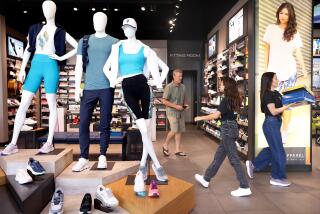Nike Hopes New High-Tech Shox Will Put Bounce Back in Sales
- Share via
BEAVERTON, Ore. — If a shock absorber can smooth the ride of something as big as a car or truck, Nike designer Bruce Kilgore figured 16 years ago it ought to work for a running shoe too.
Millions of dollars and dozens of prototypes later, the Nike Shox has arrived in stores with the endorsement of NBA star Vince Carter. With Nike Shox, the world’s largest athletic shoemaker hopes it can recover from a three-year sales slump and gain another step ahead of archrival Adidas.
“We’ve probably done more testing and development on this shoe than any other shoe we’ve ever made,” Kilgore said.
The theory behind the Shox is that a spring-like construction can cushion the impact of running or playing games like basketball. So Kilgore and other Nike designers spent years trying to mate springs to a shoe--but no material or design would hold up to the punishment a serious runner could give a pair of shoes.
The solution came in the late 1980s, after an auto parts company showed Kilgore a specialized foam used in bumpers. The material resembles hardened rubber and is placed in key areas of vehicle frame, cushioning the impact of bumps.
These bumpers “are designed to last at least 100,000 miles of hard driving,” Kilgore said. “They get exposed to salt, water, sand, dirt, snow--everything--and they don’t degrade.”
But just as the design was coming together, a proven Nike technology was taking off with consumers. Nike Air shoes with pressurized air soles helped more than double sales from $1.7 billion in 1989 to $3.8 billion just five years later, with the help of a determined marketing effort led by NBA star Michael Jordan.
The strong Air sales led Nike to decide in 1990 that the foam spring design could be put aside for a while.
The “while” lasted nearly a decade, until Nike found itself sitting on a sales plateau from which it’s still struggling to pull away from.
While Nike enjoyed $9.2 billion in worldwide revenue in its 1997 fiscal year and $9.5 billion in 1998, revenue fell to about $8.8 billion in 1999 and barely recovered to $9 billion in the fiscal year that ended last May 31.
Domestic sales also have leveled off--Nike sold $3.35 billion worth of shoes in the United States during fiscal 2000, down from $3.5 billion in 1998. In the meantime, the company’s stock, which reached a high of $75.75 in early 1997, plunged to about $26 this past March. It’s currently in the mid-$50 range.
Nike’s solution has been to take Shox off the shelf and put it on a fast track to production, coming up with a shoe designed for basketball, running and cross-training--three of the top categories for U.S. athletic shoe sales.
But Adidas is keeping pace with Nike. The Shox has made its debut at the same time Adidas is introducing its new basketball shoe, endorsed by Kobe Bryant.
Adidas-Salomon AG, the German parent of Adidas America, had also been worried about slumping North American shoe sales, declining stock value and clashes between U.S. and German executives about product design and marketing. While Nike was reviving Shox, Adidas-Salomon centralized shoe design operations in Germany and made its U.S. headquarters in Beaverton a marketing center.
The company signed Bryant for his endorsement, and chose Peter Moore, a former Nike executive who helped found Adidas America, to lead a design team that would create a new shoe around the Los Angeles Laker star.
Like Nike’s Shox, automotive design played a role, with Adidas calling in designers who helped create the Audi TT--a German sports car that has quickly found U.S. popularity. But the Adidas shoe emphasizes fashion over technology.
Analysts say the sales contest may come down to Nike bounce versus Adidas style, Carter fans versus Bryant fans, or which company has the fatter wallet for marketing.
“Is Shox a gimmick? Maybe, but the perception of athletes is that Nike has a better product,” said Josephine Esquivel, an analyst with Morgan Stanley Dean Witter in New York who has followed Nike and the athletic shoe industry for years.
“At the end of the day, Nike is one of the few companies that can put its money where its mouth is with technical products,” Esquivel said. “Not many companies can invest that much money.”
Sales of the Adidas shoe have been slow on the East Coast since the release in November, but it has done better on the West Coast, said John Shanley, a veteran analyst with First Security Van Kasper.
Nike’s Shox were “presold” in many stores to kids who waited more than a week until they were delivered, partly because Nike limited the first shipment, Shanley said. But he said that in spite of the years of research behind the Shox, the shoe’s technology probably matters less to younger buyers than the high-tech look.
On the Net:
Nike: https://www.nike.com
Adidas: https://www.adidas.com






